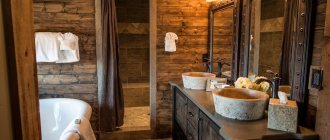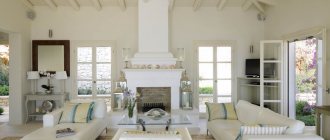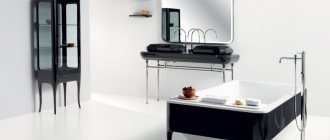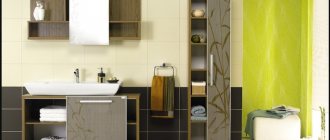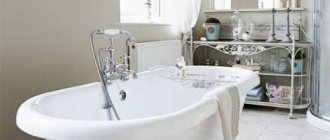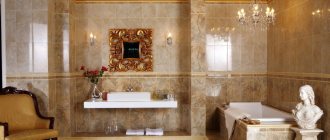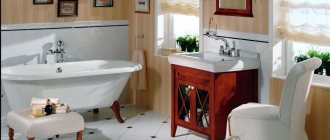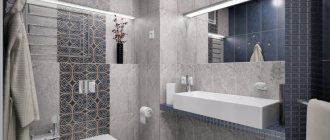The life of a modern person usually flows according to a once and for all set “work - home” scenario, so everyday life merges into one long, dull sequence, interrupted only by annual vacation. It's not surprising that people want to bring something from their rare but memorable trips into their drab everyday life.
A Moroccan-style bathroom can become just that drop of exoticism that your interior was missing, thanks to its rich colors and unique materials. In this article we will talk in more detail about this direction of design and how to implement it.
Moroccan palette
Natural cold and warm shades are evenly present in the Moroccan style, without competing with each other. The base is most often neutral:
- sand, beige, ocher;
- bronze, burnt umber, dark brown;
- white.
Natural cold and warm shades are evenly present in the Moroccan style, without competing with each other
Tones such as:
- blue in shades from turquoise to dark blue;
- green, primarily emerald, ultramarine;
- violet;
- red, including scarlet, fuchsia;
- black.
Important! Overall, the color scheme of the Moroccan style gives the impression of a positive and cheerful space, without overloading the perception or tiring the eyes.
Room layout ↑
Moroccan style is formed primarily from its architecture. Its main highlight is arches of various shapes. There are never many of them. They are used to design window and door openings, as well as internal partitions, which are often present in such rooms. If it is not possible to arrange the latter, complex arches are used as decoration for niches, cabinets and shower stalls. Niches are ubiquitous in a Moroccan bathroom. They are used as elegant decor, but at the same time are quite functional.
A niche in the wall can be designed in the form of an arch
To create “magical nooks and crannies” indoors, you can try to combine the bathroom with part of the corridor. And to create complex arches it is good to use drywall. With its help, you can build structures of any configuration and decorate them stylishly. The simplest design option is plastering followed by painting with waterproof enamel with a satin or silk effect. An even more interesting solution is to cover the surface with mosaics.
Arches of various shapes are a distinctive feature of the Moroccan style
Geometry Features
A Moroccan-style bathroom will become recognizable thanks to some design elements that are easy to implement even in a small space. One of them is an arch. Narrow and wide, horseshoe-shaped and lancet arches are used to design not only door or window openings, but also for cabinet niches, mirrors, shower stalls, and bathtubs. Even a modest arched niche for a hanger looks appropriate in the interior of this style.
A Moroccan-style bathroom will become recognizable thanks to some design elements that are easy to create even in a small space
Niches of different sizes complicate the geometry of the space, creating the intricacy necessary for oriental design, while the bathroom receives not only exquisite decor, but additional space. It is most convenient to use moisture-resistant plasterboard to construct arches and niches. Sometimes niches and arches are highlighted with mosaic decoration along the contour.
Another opportunity to emphasize the eastern orientation of the interior is to make the ceiling domed or designate vaults; plasterboard will again help with this
Another opportunity to emphasize the eastern orientation of the interior is to make the ceiling domed or designate vaults; plasterboard will again help with this.
Moroccan style in the interior of the bathroom
Moroccan style is truly exotic for Russian people. Of all the styles, it is probably one of the most recent to remember. In addition, its unpopularity in our country is caused by the high cost of execution. But if you have decided to use it in the interior of your bathroom, then you can be one hundred percent sure that there is nothing similar in the area that could compare with the result of your work.
Finishing the ceiling, walls and floor
In the Moroccan style, naturalness is encouraged, so the ceiling can simply be plastered and painted with waterproof paint in a neutral shade. If you have a sufficient budget for repairs, you can decorate the ceiling with stretch film with a pattern or carved wooden panels. The panels must be treated against rot and fungus; the presence of treatment is usually confirmed by a certificate.
In the Moroccan style, naturalness is encouraged, so the ceiling can simply be plastered and painted with waterproof paint in a neutral shade
The main focus is on the wall covering. In this capacity it is used:
- a rough layer of plaster coated with paint, imitating an adobe building;
- decorative plaster with a glossy effect creating the appearance of marble walls;
- large ceramic tiles with oriental patterns;
- small glossy mosaic up to 4x4 cm in size;
- ceramic cubes measuring 2x2 cm, which are traditionally called zelij;
- combined option.
To create a Moroccan style, tiles with traditionally oriental patterns are suitable, among them geometric patterns predominate (octahedrons, stars, rhombuses, squares). Such tiles are connected to each other according to mathematical rules, not chaotically. Tiles with a floral pattern look beautiful.
To create a Moroccan style, tiles with traditionally oriental patterns are suitable, among them geometric patterns predominate (octahedrons, stars, rhombuses, squares)
Moroccan tiles in the patchwork style look especially interesting. Selecting tile patterns on your own is quite difficult; it requires impeccable taste, so among the collections of ceramics you can choose ready-made versions of various patterns in a variety of colors.
By combining a plastered surface with ceramic inserts, you can get an interesting interior in which some areas (near the sink, shower) are highlighted with bright tiles.
Traditionally, in Morocco, floors are covered with stone tiles, which keep the room cool, but in domestic bathrooms it is necessary to first install a “warm floor” system
A frieze made of carved wood is installed at the junction between the ceiling and walls.
Important! Plastic products are inappropriate in a Moroccan-style bathroom.
Traditionally, in Morocco, floors are covered with stone tiles, which keep the room cool, but in domestic bathrooms it is necessary to first install a “warm floor” system. To save money, porcelain tiles, which have excellent decorative and functional qualities, are often laid on the floor.
History of origin
Moroccan style is the general name for a design direction that combines the architectural traditions of North Africa and Southern Europe. Being at the crossroads of cultures, these nationalities accumulated customs, way of life, religions, mixed them and got a bright, exotic cocktail. The birthplace and founder of this style was the small but distinctive state of Morocco, which was like a border between two cultures and continents. Therefore, the Moroccan style combines the following trends:
- The basis of the style was the life of the indigenous peoples of North Africa, the Berbers, warlike nomads who did not stay in one place for long.
- Then the Arabs invaded this territory, bringing their religion, everyday customs and culture into the life of the indigenous population.
- The final influence on the formation of the famous Moroccan style was exerted by various colonialists from Europe, who ennobled it and then brought it to their homeland.
It is interesting that African motifs still played a key role in style formation; this can be seen in the characteristic patterns and ornaments on textiles. The Arab influence is clearly visible in the design of ceramic tiles and recognizable architecture.
Features of the appearance of plumbing fixtures
In various photographs, a Moroccan-style bathroom immediately stands out due to its unusual design forms of plumbing fixtures. Since ancient times, Moroccan baths have been equipped with large round pools, sunk into the floor and lined with fine mosaic tiles.
Therefore, it is better to opt for a round or semicircular bath or shower. Ideally, the bathtub will be deepened, and you need to climb several steps to reach it.
Ideally, the bathtub will be deepened, and you need to climb several steps to get to it.
The sink should be preferred:
- round or oval shape;
- made of copper or bronze alloy, stone or successfully stylized as them;
- decorated with oriental ornaments;
- built into a table or one that is placed on top like a bowl.
It’s great if the sink evokes associations with traditional oriental bowls for washing hands, then the choice was made well.
If you plan to place a washing machine and dryer in the bathroom, it is better to hide them from view using niches or decorative protrusions. Modern technology does not harmonize well with ethnic styles, which include Moroccan.
Bath or pool?
In a bathroom stylized as Morocco, the bathtubs themselves are quite unusual in their volume: they are heavy, wide, and resemble a mini-pool.
Moreover, the area for taking water procedures with the whole body is separated from the main area by an impressive arch. They are heavy, massive and rather like a swimming pool. Very often, the bath is separated from the main area with an arched opening or ringing curtains reminiscent of rain.
An important part of the interior is accessories
A Moroccan-style bathroom (the photos in our article offer different design options) is necessarily decorated with textiles and trinkets. The effect is achieved not by the number of accessories, but by their correct selection and placement. What is needed to create the authentic spirit of Morocco:
- Textile. If the bathroom has windows, great; they can be covered with thick textured curtains. Using waterproof fabric with oriental patterns, it’s easy to make something like a tent around a bathtub or shower stall. A woven drapery separating a hanger or a place for a washing machine will also decorate the room. Rugs with ethnic patterns look great on the floor. Towels and bathrobes must be selected to match the color scheme of the room.
- Mirror. A round or oval mirror is framed in a wooden or copper frame; a fine ceramic mosaic edging is suitable.
- Lighting. You can create a style using just one bright touch - Moroccan lanterns. Slightly elongated bowl-shaped lamps are made of copper and decorated with carvings and colored glass inserts. Such lamps are hung on fairly thick, strong chains, either singly or several in a row. 1-2 wall lamps or candlesticks made of forged metal in black or bronze color fit perfectly into the bathroom interior.
- Furniture. A small amount of furniture is usually used in the bathroom, but if the size of the room allows, a low ottoman or a couch with many pillows would look appropriate. This sofa immediately creates an atmosphere of oriental bliss and luxury.
Select furniture items (including a wardrobe or chair) from dark-colored wood, preferably cedar, beech or thuja
Select furniture items (including a wardrobe or chair) from dark-colored wood, preferably cedar, beech or thuja. The shape of the products is rectangular, slightly elongated, on strong legs. Decorate bathroom furniture:
- forged elements;
- carving;
- mother-of-pearl inlays;
- mosaic inserts;
- hand painted with ethnic motifs.
Moroccan style looks exotic and at the same time cozy, it does not become boring and does not go out of fashion, so it is great for decorating a bathroom
Moroccan style looks exotic and at the same time cozy, it does not become boring and does not go out of fashion, so it is great for decorating a bathroom.
Trying to fit into the frame
To recreate the atmosphere of the fabulous East, let's try to start with a traditional arch. It can be made of plasterboard and covered with waterproof paint with a satin or silk effect. Instead of tiles, mosaics can be used to decorate such an element.
It will cost more, but at the same time the move is strong, and you will be more than one step closer to style.
If you want to use the usual ceramic tiles for decoration, then remember that the Moroccan style accepts the use of tiles of a maximum size of only 15x15cm with a pronounced oriental pattern. Moreover, ornaments, drawings and Arabic script are used in the bathroom everywhere you can imagine.
The complexity and exoticism of the Moroccan style lies not only in the patterns, but also in any details such as plumbing fixtures of unusual shapes, which are truly exclusive. That is why few people can afford such a style in their apartment. However, it is not always necessary to follow the Moroccan style rule of purchasing expensive interior items. You can often find much cheaper analogues that will fit into the space just as well.
For example, a sink can be quite varied in design, shape, color and design, so you will have the opportunity to choose from the model ranges something that is most suitable and fits your budget.
